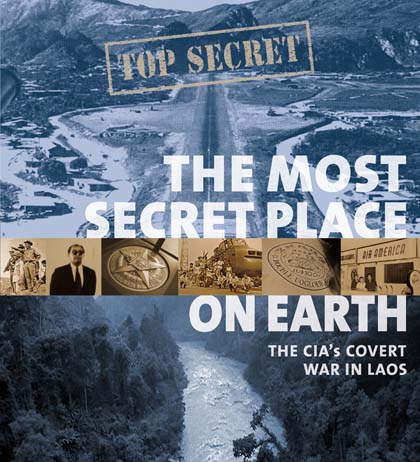March 2013


The Most Secret Place on Earth is a 2008 film by German director Marc Eberle.
After 30 years of conspiracy theories and myth making, this film uncovers the story of the CIA’s most extensive clandestine operation in the history of modern warfare: The Secret War in Laos, which was conducted alongside the Vietnam War from 1964 -1973. While the world’s attention was caught by the conflict in Vietnam, the CIA built the busiest military airport in the world in neighboring and neutral Laos and recruited humanitarian aid personnel, Special Forces agents and civilian pilots to undertake what would become the most effective operation of counterinsurgency warfare.
As the conflict in Vietnam grew, the objective in Laos changed from a cost effective low-key involvement to save the country from becoming communist into an all-out air war to cut the Ho Chi Minh Trail and bomb Laos back into the Stone Age that it had never really left in the first place. Conventional bombs equivalent to the destructive power of 20 Hiroshima-type weapons fell on Laos each year – 2 million tons of bombs, more than on Europe and the Pacific theatre combined during World War II. Until today much of the countryside is poisoned by Agent Orange and littered with unexploded ordnance.
In “The most secret place on earth” key players of the secret war – CIA agents, pilots, Laotian and Thai fighters -take us on a journey into the physical heart of the conflict: Top secret Long Tieng. Long Tieng was often described as “The Most Secret Place on Earth”. It was located in a valley at 3,100 feet elevation, high enough to have chilly nights and cold fogs. It was surrounded by mountains and on the northwest side of the runway were karst outcrops several hundred feet high. In the shadow of the Karst outcrops was “Sky” the CIA headquarters in Long Tieng. Jerry Daniels, a CIA officer codenamed “Hog,” is said to have named Sky after his home state of Montana, known as “Big Sky Country.” Long Tieng was protected on three sides by limestone mountains.
The story is told with archival images, interviews and contemporary shots of both Laos and the US. Some of the archive footage is previously unpublished and comes from private collections of former US personnel stationed in Laos, and from the Lao Film Archives – these had never before been screened. The interviews are conducted in a way to characterize the interviewees in their respective roles within the film. A voice over narration is sparsely applied where necessary. The investigative story telling is rendered by declassified documents, maps and newspaper clippings. Contemporary shots of both US government bodies (Congress, CIA Headquarters, the White House) and Laotian sceneries drive at a metaphoric visual rendering and connect the aftermath of the secret war in Laos to the machinations in the jungles of Washington 30 years ago. Americas Secret war in Laos tells of the absurd brutality of a conflict, that has barely been documented in it’s full extent and yet cost up to hundreds of thousand lives.
After 30 years of conspiracy theories and myth making, this film uncovers the story of the CIA’s most extensive clandestine operation in the history of modern warfare: The Secret War in Laos, which was conducted alongside the Vietnam War from 1964 -1973. While the world’s attention was caught by the conflict in Vietnam, the CIA built the busiest military airport in the world in neighboring and neutral Laos and recruited humanitarian aid personnel, Special Forces agents and civilian pilots to undertake what would become the most effective operation of counterinsurgency warfare.
As the conflict in Vietnam grew, the objective in Laos changed from a cost effective low-key involvement to save the country from becoming communist into an all-out air war to cut the Ho Chi Minh Trail and bomb Laos back into the Stone Age that it had never really left in the first place. Conventional bombs equivalent to the destructive power of 20 Hiroshima-type weapons fell on Laos each year – 2 million tons of bombs, more than on Europe and the Pacific theatre combined during World War II. Until today much of the countryside is poisoned by Agent Orange and littered with unexploded ordnance.
In “The most secret place on earth” key players of the secret war – CIA agents, pilots, Laotian and Thai fighters -take us on a journey into the physical heart of the conflict: Top secret Long Tieng. Long Tieng was often described as “The Most Secret Place on Earth”. It was located in a valley at 3,100 feet elevation, high enough to have chilly nights and cold fogs. It was surrounded by mountains and on the northwest side of the runway were karst outcrops several hundred feet high. In the shadow of the Karst outcrops was “Sky” the CIA headquarters in Long Tieng. Jerry Daniels, a CIA officer codenamed “Hog,” is said to have named Sky after his home state of Montana, known as “Big Sky Country.” Long Tieng was protected on three sides by limestone mountains.
The story is told with archival images, interviews and contemporary shots of both Laos and the US. Some of the archive footage is previously unpublished and comes from private collections of former US personnel stationed in Laos, and from the Lao Film Archives – these had never before been screened. The interviews are conducted in a way to characterize the interviewees in their respective roles within the film. A voice over narration is sparsely applied where necessary. The investigative story telling is rendered by declassified documents, maps and newspaper clippings. Contemporary shots of both US government bodies (Congress, CIA Headquarters, the White House) and Laotian sceneries drive at a metaphoric visual rendering and connect the aftermath of the secret war in Laos to the machinations in the jungles of Washington 30 years ago. Americas Secret war in Laos tells of the absurd brutality of a conflict, that has barely been documented in it’s full extent and yet cost up to hundreds of thousand lives.
Full film below.














